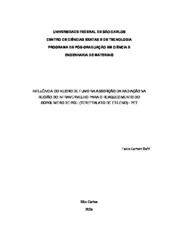| dc.contributor.author | Sofri, Fabio Lamon | |
| dc.date.accessioned | 2016-06-02T19:11:45Z | |
| dc.date.available | 2007-07-10 | |
| dc.date.available | 2016-06-02T19:11:45Z | |
| dc.date.issued | 2005-08-06 | |
| dc.identifier.citation | SOFRI, Fabio Lamon. The influence of carbon black in the infrared absorption during the heating up of the polyethylene terephthalate.. 2005. 185 f. Dissertação (Mestrado em Ciências Exatas e da Terra) - Universidade Federal de São Carlos, São Carlos, 2005. | por |
| dc.identifier.uri | https://repositorio.ufscar.br/handle/ufscar/749 | |
| dc.description.abstract | The objective of this work was to study the influence of the use of carbon
black as infrared absorber to improve the PET resin heat-up during the
stretching blow molding of bottles. It was investigated the correlation between
the main physical properties of the carbon blacks and the source setup
conditions and the PET infrared absorption. Therefore, five carbon blacks with
different physical characteristics were selected and mixed with a PET resin
bottle grade by injection molding. The correlation between particle size, surface
area and structure of carbon black and the optical properties, rheological
behavior and heat-up of the compositions were studied. The rheological
measurements showed that the carbon blacks did not modify the profile of the
PET rheological curve; however both the viscosity and elasticity properties of
the PET were dependent on the carbon black particle size and structure. The
differential scanning calorimetry (DSC) results showed that the carbon black
particles modified the PET crystallization kinetics by increasing the induced
crystallization temperature during the cooling step. Through the L* a* b* color
measurements, it was verified that the L* color was indirectly proportional to the
carbon black content. Finally, the heat-up performance was investigated using
two methods: (a) the surface temperature measurement of samples heated
under infrared lamps and, (b) the total absorption of each composition
calculated using the spectrum data obtained by near infrared spectroscopy
(NIRS). Using the scanning electron microscopy (SEM) it was verified that the
carbon black content did not modify significantly the morphological aspect and
the fracture surface of the compositions. | eng |
| dc.format | application/pdf | por |
| dc.language | por | por |
| dc.publisher | Universidade Federal de São Carlos | por |
| dc.rights | Acesso Aberto | por |
| dc.subject | Polímeros | por |
| dc.subject | Reologia | por |
| dc.subject | Processamento de polímeros | por |
| dc.subject | Reaquecimento | por |
| dc.subject | Moldagem por sopro | por |
| dc.title | Influência do negro de fumo na absorção da radiação na região do infravermelho para o reaquecimento do copolímero de poli(tereftalato de etileno) - PET. | por |
| dc.title.alternative | The influence of carbon black in the infrared absorption during the heating up of the polyethylene terephthalate. | eng |
| dc.type | Dissertação | por |
| dc.contributor.advisor1 | Bretas, Rosario Elida Suman | |
| dc.contributor.advisor1Lattes | http://genos.cnpq.br:12010/dwlattes/owa/consultapesq.prc_querylist | por |
| dc.description.resumo | O objetivo deste trabalho foi estudar a tecnologia de utilização do negro
de fumo como absorvedor de radiação infravermelha para o reaquecimento da
resina PET durante o ciclo de sopro de garrafas. Foi investigada a correlação
entre as principais características físicas do negro de fumo e as condições de
operação da fonte de radiação empregada no reaquecimento, e o fenômeno de
absorção da radiação infravermelha da resina PET. Para tal, foram
selecionados cinco tipos de negro de fumo com características físicas
diferentes, e incorporados em uma resina PET grau garrafa, através da
moldagem por injeção. Foi estudada a correlação entre o tamanho de partícula
primária, área superficial e estrutura do negro de fumo, e as características
óticas, o comportamento reológico, e o reaquecimento das composições. As
medidas reológicas mostraram que a incorporação de baixos teores de negro
de fumo não modificou o perfil da curva reológica do PET; contudo, a
viscosidade e a elasticidade foram dependentes do tamanho de partícula e da
estrutura do negro de fumo. Os resultados de calorimetria exploratória
diferencial (DSC) mostraram que as partículas de negro de fumo atuaram como
nucleantes e modificaram a cinética de cristalização do PET, aumentando a
temperatura de indução cristalina no resfriamento. Através das medidas de cor
L* a* b*, verificou-se que o teor de negro de fumo e cor L* são inversamente
proporcionais. Finalmente, a performance de reaquecimento foi investigada por
duas metodologias: (a) medidas de temperatura na superfície dos corpos de
prova reaquecido sob painel de lâmpadas infravermelhas e, (b) cálculo da
absortividade total ) (a das composições a partir da espectroscopia na região
do infravermelho próximo (NIR). Utilizando a microscopia eletrônica de
varredura (MEV) pode-se observar que a presença de baixos teores de negro
de fumo não alterou, significativamente, o aspecto da morfologia e a superfície
de fratura das composições. | por |
| dc.publisher.country | BR | por |
| dc.publisher.initials | UFSCar | por |
| dc.publisher.program | Programa de Pós-Graduação em Ciência e Engenharia de Materiais - PPGCEM | por |
| dc.subject.cnpq | ENGENHARIAS::ENGENHARIA QUIMICA::TECNOLOGIA QUIMICA::POLIMEROS | por |
